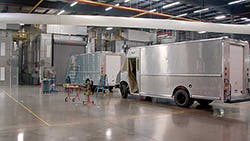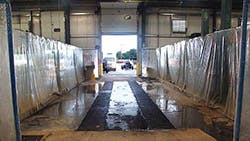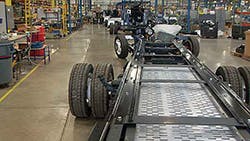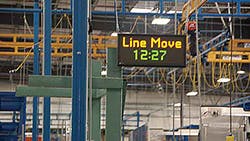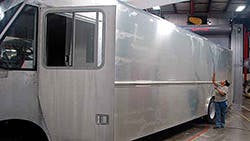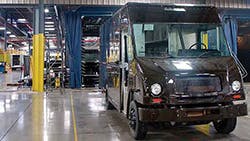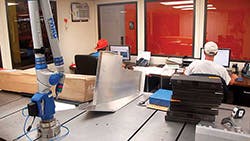BIGGER isn’t necessarily better. Just ask the team at Utilimaster who are now able to build more walk-in vans and truck bodies in less floor space.
The key: getting everything under one easily manageable roof.
For 40 years, Utilimaster produced a variety of vehicles at its multi-building campus in Wakarusa, Indiana. That complex had grown significantly over time--to 17 buildings spread out across approximately a half-mile stretch of State Road 19. In 2013 the company moved its operation to nearby Bristol, Indiana, where most of its manufacturing operation now fits nicely inside a single building.
The company still manufactures dry-freight truck bodies and cut-aways back in Wakarusa. But production of walk-in vans (including its Reach model), high-volume cutaways, along with van upfits, is now completed under one 487,000-sq-ft roof in Bristol. “Our facilities in Wakarusa required a batch and queue approach,” says John Forbes, president. “We would partially build a batch and then move the vehicles to the next building for additional work. It was not the most efficient method to manufacture. So many things become easier and more efficient when they are all under one roof.”
How much difference has the new plant made? Try this stat: The batch and queue approach in the old facility required approximately 17 work days to complete a vehicle. At the new Bristol plant, a vehicle moves from start to finish in 2.8 days. How? With a continuous flow approach, the vehicle moves smoothly through the production process, eliminating the waiting time that is inherent with batch and queue.
Keeping the team together
Utilimaster invested more than $10 million to convert a former warehouse into a vehicle manufacturing plant.
“We were fortunate to find a facility that met our needs and was so close to home,” Forbes says. “We considered all options, including moving to Michigan or the Southeast. But we wanted to keep our team together.”
The Bristol plant is only 22 miles from Wakarusa, but management nevertheless was concerned about the impact the move would have on its employees.
The impact of the move, of course, varied according to where each employee lived. Those who lived west of Wakarusa were the most adversely impacted, while those living east of town had their commutes reduced.
“We looked at each person’s home address and estimated the effect the move would have on them,” Forbes says. “For some, it meant an additional 22-mile drive. The move could mean a longer commute for many of our employees, although the difference was marginal for most. In the end, we were able to retain more than 85% of our employees.”
Overcoming obstacles
The move to the new plant, which started production in 2013, was more than a new location. For Utilimaster, it was a new way of building vehicles.
“We moved from a larger footprint in numerous buildings to a smaller one, and we went from a batch and queue to a continuous flow production process,” says Steve Claude, director of value streams (operations). “We faced many different changes.”
“We came into this operation with a shared vision,” Forbes says. “It was unlike our previous way of manufacturing, so much so that we treated everyone as a new employee. We provided them each with 40 hours of training before they ever went to work in Bristol. Our goal was to implement a new culture with new objectives about on-time delivery, safety, and each person’s involvement in our continuous improvement efforts. We wanted everyone on our team to understand how we are performing.”
New approach
The Utilimaster approach to operations views everyone in the organization as part of a team. Each member of the team is responsible to one another and to the team, and the functional teams have responsibility to each other. The work flows through the system—from sales, to engineering, to manufacturing, to delivery. As each team completes its work, it hands the job off to the next one. The team receiving the job is viewed as the customer.
“This is not just a manufacturing approach,” Forbes says. “Sales, engineering, materials scheduling all play key roles. . We are achieving high quality output in part because we are spending significant time upfront to eliminate problems before they have a chance to occur downstream.
“For this to work, though, we have to have people who are willing to be held accountable throughout the value stream. The company’s approach is reflected in Steve Claude’s job title—director of value streams.
“Most people in my position would be called the operations manager,” he explains. “But there is a big difference. An operations manager is focused on results of one area. A value stream manager concentrates on having good hand-offs, holding each team in the process accountable. Your customer is working in the workstation next to yours, and he must accept the product that you have produced. The system emphasizes high quality, and it has built-in checks to identify mistakes and correct them right away.”
Providing incentives
A bonus system serves as a reminder that each individual performance affects company performance—and the company’s ability to reward that performance.
The bonus, paid quarterly, is based on four components:
1. On-time delivery.
2. Involvement in continuous improvement projects. Utilimaster may have 70 different continuous improvement projects going in a given quarter.
3. Labor productivity.
4. Company profitability. As Forbes observes, the company can’t pay a bonus if it is not making any money.
Utilimaster is very transparent about how well the company is performing and, by extension, how that quarterly bonus might be shaping up.
“We report and share information weekly and monthly,” Forbes says. “We have shouted from the mountaintops the bonus program is designed to benefit the employee and the company. When the company pays bonuses, that means things are going well. .”
The weekly meetings include analysis of where any errors may have occurred during the past week.
“This was a major change for us, a cultural change across the board,” Claude says. “Improvements were more difficult to achieve when we were in multiple plants and trying to hand off work from one plant to another. The new location helps the team work better together and drive improvements.”
Making the switch
In February of 2012, management announced that the company would be moving in one year. One challenge: Evaluating the 78 different layouts for the plant that were developed during that year.
“We put some of the layout options by the time clock so our entire team could review,” Forbes says. “And we encouraged input.
The result was a plant that includes a chassis upfit line, 15 work stations for body production, more than a dozen upfit stations, a state-of-the-art paint facility, a water test bay, and final quality inspection.
“By the time the truck is water tested, it has been evaluated several times along the way,” Forbes says. “We have a number of quality auditing check points. We also check quality within each work station. Everyone working in that station owns the work done at that station.”
Laser-guided installation
Tolerances are much tighter at the Bristol location.
“We are passionate about making sure that everything is square,” Claude says.
To make it square, the process must start square. As jigs and fixtures were assembled and put into place, lasers were used to align them.
“The investment in jigs and fixtures has allowed us to have a much more repeatable assembly process, resulting in a superior final product. “We have talked about how our departments serve one another,” says David Dillon, director of engineering. “We asked ourselves how engineering contributes to making our production more efficient. The most significant way is to design components in a way that reduces variation and then to manage that variation.”
Utilimaster uses datum schemes that identify points in four dimensions and jigs that lock everything in place.
“Variation is inevitable in manufacturing,” Dillon says. “When you reduce variation, you improve efficiency.”
Reducing engineering lead time
The engineering department is not exempt from demands for continuous improvement. The department has trimmed engineering lead times from an average of 10-11 weeks down to three weeks now.
“Demand can fluctuate extensively,” Dillon says. “We need a way to be able to reasonably engineer a product in an acceptable amount of time during peak season without being overstaffed during slower periods. We hire third parties as required, and add resources, including additional personnel, as appropriate.
“Using third parties allows us to gain flexibility and optimize our cost structure. We have taken on quite a few initiatives recently that have helped us reduce costs and enhance margins.”
Open communication
Keeping communication flowing is key at the new Utilimaster plant.
“Every week we take 12 people off the shop floor and bi-weekly 12 people from the office,” Claude says. “We talk about what we would like to see happen and ideas for making things better. It’s a commitment we keep every week, something that shows everyone that this company values the people who work here and what they have to say.”
Communication also is key for keeping the plant running smoothly.
“Every morning at 7 a.m., team leaders walk the plant and review where we are,” Claude says. “They look for potential bottlenecks and assess how to address them before they occur.”
Utilimaster has implemented 1HC—one-hour containment. If a problem does occur at a particular point in the plant, next-level management is notified so that help can be provided.
“We want everyone to get the help they need when they need it,” Claude says. “It’s our goal to provide everyone with the resources they need to succeed.”
It has been a very eventful couple of years for the company, one in which far more than the location has changed. In spite of considerable planning, changing company culture, along with where and how products are manufactured, the changes were not always smooth ones.
“We let some customers down during that transition period,” Forbes says. “The question then was ‘How do we respond?’ The first 90 days were difficult, and we deeply appreciate how our customers stuck with us. By the fourth quarter of 2013, we began seeing the operational gains that we sought when we moved in. We hit our stride in 2014 with improvements in on-time delivery, cost, and quality. We remain focused on continuous improvement and we are confident our best days lie ahead..” ♦
About the Author
Bruce Sauer
Editor
Bruce Sauer has been writing about the truck trailer, truck body and truck equipment industries since joining Trailer/Body Builders as an associate editor in 1974. During his career at Trailer/Body Builders, he has served as the magazine's managing editor and executive editor before being named editor of the magazine in 1999. He holds a Bachelor of Journalism degree from the University of Texas at Austin.

